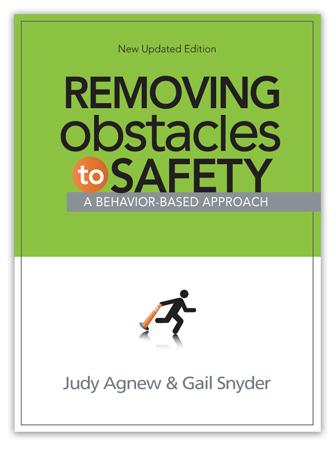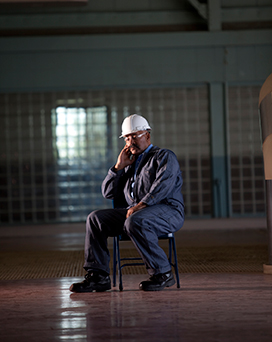Sustaining BBS by Going Back to Basics
First viewed by many as a soft approach to managing safety, behavior-based safety (BBS), a technology based on the science of behavior analysis, has earned respect during the past 40 years. In fact the Cambridge Center for Behavioral Studies reports, “In workplaces with troublesome rates of unsafe performance, behavioral safety programs, properly implemented, produce significant improvements in safe performance and major reductions in workplace injuries and illnesses. Human suffering and financial costs are sharply reduced. Moreover, the costs of producing these gains in human performance are a good investment, paying for themselves many times over.” Not only has BBS proved its worth for companies with troublesome injury problems, but also for companies who have reached high level plateaus and are looking for more proactive safety measures. BBS has become a criterion for advanced safety programs striving for world-class or best-practice status. This is commendable, especially with the uphill battle that BBS has had to endure to prove its worth along the way.
As a behavioral safety consultant for the past 20 years, I’ve seen a wide variety of BBS processes designed to change behavior and reduce workplace injuries. I’ve seen many companies reach excellence where safe behaviors have become long-lasting habits, not only in the workplace but also at home. These companies have transformed their cultures into proactive and positive work environments. I’ve also seen many well-intentioned organizations pouring their time and energy into programs that by their very nature won’t get them the results they could or, worse, could get them the opposite results they are intending. This is heart breaking.
What is it that causes such a wide difference between successful BBS programs and ones that seem to miss the mark? How can you ensure your process is reaching its full potential? My experience has taught me the most effective and sustaining BBS programs stand on one key foundation: the closer a process is to the science of behavior, the better. With this key foundation as a point of reference, this article gets back to the basics and helps point to areas for improving and sustaining your current BBS process, not by focusing on what’s next, but by getting back to what’s first.
The Science of Behavior – Back to Basics
Can you make a light bulb work without using the laws of electricity correctly? Can you build a bridge without applying scientific laws of civil engineering? As we all know by now, BBS is built on scientific laws of behavior, which have been proven to work through decades of research. Through these laws, we now know how people learn new behaviors (safe and unsafe). A good BBS process applies these laws to change behavior in ways that maximize human potential, bring out the best in people at all levels, and dramatically improve business results, leading to positive culture change.
 All too often in a haste to implement BBS, however, process elements are not evaluated for their alignment with the science. Or, over time without proper monitoring, a BBS program deviates from the foundational principles causing process drift. In each case, when a process no longer stands on or is no longer aligned with the science, failure is imminent: the light bulb won’t work, the bridge fails, or human potential is diminished causing fear-based environments and stagnant business results. Many well-intentioned organizations are creating unintentional, detrimental results simply by a misunderstanding or misuse of the foundational laws of behavior. Without awareness, they start blaming the light switch, the structural beams or BBS overall instead of the real cause of failure...a process misaligned with the science.
All too often in a haste to implement BBS, however, process elements are not evaluated for their alignment with the science. Or, over time without proper monitoring, a BBS program deviates from the foundational principles causing process drift. In each case, when a process no longer stands on or is no longer aligned with the science, failure is imminent: the light bulb won’t work, the bridge fails, or human potential is diminished causing fear-based environments and stagnant business results. Many well-intentioned organizations are creating unintentional, detrimental results simply by a misunderstanding or misuse of the foundational laws of behavior. Without awareness, they start blaming the light switch, the structural beams or BBS overall instead of the real cause of failure...a process misaligned with the science.
Consider a wheel that is a little off balance and how much it wobbles on the periphery. When you attach your process to off balanced wheels at the start, the whole process becomes imbalanced and begins turning off center at every layer. Or envision setting sail for Bermuda from Miami and being 1 degree off course. Where will you end up and how far off course will you be when you arrive? It’s obvious that a small difference in degree at the start can lead to a large difference from the intended outcome. Sadly, many companies don’t even realize they have based their programs on false centers or are off a slight degree from the scientific principles of behavior causing an even greater divide from the results they were hoping to achieve. This is particularly worrisome when the lives and wellbeing of employees are at stake.
 Excellence in BBS begins with a solid foundation of the science of behavior. Therefore, an objective evaluation of your process and its relation to the science is needed to determine “what is” or where you are now. To many of us, this may be difficult to do. We have built up many ideas, perceptions, preconceptions, and automatic responses of what we think of as the science of behavior or behavior-based safety. Even the word “behavior” conjures up various automatic subjective responses often with strong emotional undertones. Through deeper inquiry, it is often humbly revealed that what we think we already know about behavior is the greatest barrier to applying the science correctly and the difference between maximizing and diminishing human potential.
Excellence in BBS begins with a solid foundation of the science of behavior. Therefore, an objective evaluation of your process and its relation to the science is needed to determine “what is” or where you are now. To many of us, this may be difficult to do. We have built up many ideas, perceptions, preconceptions, and automatic responses of what we think of as the science of behavior or behavior-based safety. Even the word “behavior” conjures up various automatic subjective responses often with strong emotional undertones. Through deeper inquiry, it is often humbly revealed that what we think we already know about behavior is the greatest barrier to applying the science correctly and the difference between maximizing and diminishing human potential.
The key point: there is a big difference between the ideas we have about something (what we think we know) and “what is.” Science is always focused on objective reality or “what is.” That’s why science is dependable for building structures. Without that objective reality, structures would fail. The same is true for the science of behavior. The ability to make this distinction between what you intend to do and what you actually do is crucial to evaluating BBS. In fact, in light of the many safety disasters still occurring today, it’s a moral imperative.
How closely your BBS process translates and applies the science is critical for sustaining it and/or making it better. But how do you evaluate whether your process is close to the science or has drifted off course? There are many ways to evaluate a process depending on how far down the rabbit hole you want to go. External consultants can certainly provide an in depth assessment of your process from an objective viewpoint, provided they have an understanding of the scientific principles themselves and know how to apply them. However, sometimes your own inquiry and honest self-assessment can be the right place to start. All that’s required is a willingness to evaluate your own knowledge of the science and process, and how it affects your overall organizational context. You just might be the difference that makes the difference.
 In their book, Removing Obstacles to Safety – A Behavior-Based Approach, Judy Agnew and Gail Snyder provide a simple explanation of “what we know about behavior.” This is refreshing as many explanations of the science of behavior are quite daunting. Next they provide a simple explanation on “how to apply what we know.” While the book provides more detail, outlined below are some of the broad questions that can be used to assess your knowledge of the science (what you know about behavior) and your process (how you are applying what you know). The intention is to reveal your own areas of weakness or ignorance so that you can begin to close the gaps.
In their book, Removing Obstacles to Safety – A Behavior-Based Approach, Judy Agnew and Gail Snyder provide a simple explanation of “what we know about behavior.” This is refreshing as many explanations of the science of behavior are quite daunting. Next they provide a simple explanation on “how to apply what we know.” While the book provides more detail, outlined below are some of the broad questions that can be used to assess your knowledge of the science (what you know about behavior) and your process (how you are applying what you know). The intention is to reveal your own areas of weakness or ignorance so that you can begin to close the gaps.
Assessing What You Know About Behavior
- Do you understand how behavior is learned and how habits are formed? Behavior is always changing. Our behaviors are shaped (or learned) every day based on consequences in our environment. The more positive, immediate and certain the consequences, the more you repeat the behavior, even if the behavior is not good for us or puts us at-risk. If we’re not aware of this shaping process and how consequences are affecting our behaviors, over time they become unconscious habits. The more you can step back and observe the shaping process, the better you can respond with right action.
- Do you understand why people engage in at-risk behavior? The more you understand the complex and systemic reasons for at-risk behavior, the better able you are to use your BBS process to target the underlying causes, which leads to more sustainable improvement. Such analyses include understanding the relative impact of antecedents and consequences and the understanding that most behavior is influenced by multiple consequences. Changing these consequences is most often the key to improved safety.
- Do you understand the powerful impact of Immediate and Certain consequences? It is essential to look at all consequences for safe and at-risk behavior and to look at whether they are Positive or Negative, Immediate or Future, Certain or Uncertain. Such analysis allows you to target your efforts to counteract powerful PICs (Positive, Immediate, Certain) for at-risk behavior and NICs (Negative, Immediate, Certain) for safe behavior. Furthermore, a thorough analysis of consequences almost always reveals some management-controlled barriers (unsafe conditions or competing systems) to safe behavior that must be remediated in order for lasting change to occur.
 Do you understand the effects and side effects that each consequence has in safety? In order to optimize safety performance, it is important to understand the relative effects of the consequences of positive reinforcement, negative reinforcement, punishment and the process of extinction. Each consequence or process has a predictable effect on behavior and, equally important, has predictable side effects that should be considered. It is particularly important to understand the dangers of negative reinforcement and punishment in safety and to have a clear understanding of alternative methods to decrease at-risk and increase safe behavior.
Do you understand the effects and side effects that each consequence has in safety? In order to optimize safety performance, it is important to understand the relative effects of the consequences of positive reinforcement, negative reinforcement, punishment and the process of extinction. Each consequence or process has a predictable effect on behavior and, equally important, has predictable side effects that should be considered. It is particularly important to understand the dangers of negative reinforcement and punishment in safety and to have a clear understanding of alternative methods to decrease at-risk and increase safe behavior.
- Do you understand positive reinforcement? While all consequences must be understood and applied appropriately, positive reinforcement seems to be the one misunderstood the most. Positive reinforcement is defined by its functional effect on behavior—it increases the frequency of the behavior it follows—because the receiver experienced something good and wants to experience it again. As with all consequences, positive reinforcement comes from many sources and is based on the individual receiving it, and as we know, everyone is different. Positive comments, a pat on the back, certificates, or trinkets may or may not be reinforcement depending on many factors such as individual preferences, timing, or sincerity. Therefore, when applying reinforcement deliberately, extra effort is required to notice the impact your action had on the behavior you are trying to reinforce. Only if the behavior occurs again can you call what you said or did positive reinforcement. This extra effort is worthwhile when we realize there are no limits to what a person can achieve with positive reinforcement. Establishing good relationships is the key to making your reinforcement more meaningful to others.
 In addition to assessing your knowledge of the science of behavior, it is also important to assess your current process or your application of the science. Here are some questions that can be used to begin assessing your application. Again, more detail can be found in Removing Obstacles to Safety.
In addition to assessing your knowledge of the science of behavior, it is also important to assess your current process or your application of the science. Here are some questions that can be used to begin assessing your application. Again, more detail can be found in Removing Obstacles to Safety.
Assessing How to Apply What You Know
- Are you targeting the right behaviors? A behavioral observation system is only as good as the behaviors that are targeted for observation. It is important to ensure that the behaviors observed are the behaviors that are most likely to prevent incidents, especially serious ones. In addition, focusing on a critical few is far more effective than focusing on too many. Furthermore, behaviors should be pinpointed so there is universal clarity around the safe behaviors.
 Are observations done frequently enough? Frequent observations lead to frequent feedback and reinforcement, which leads to faster improvement. When observations are done infrequently (just a few times a month) the rate of change is slow. More frequent observations also provide a more accurate picture of the true frequency of safe and at-risk behavior. Creating an environment where employees want to observe and participate is critical to ensure enough observations are made and the data are meaningful and reliable.
Are observations done frequently enough? Frequent observations lead to frequent feedback and reinforcement, which leads to faster improvement. When observations are done infrequently (just a few times a month) the rate of change is slow. More frequent observations also provide a more accurate picture of the true frequency of safe and at-risk behavior. Creating an environment where employees want to observe and participate is critical to ensure enough observations are made and the data are meaningful and reliable.
- Do you understand various forms of feedback and what makes it effective? Feedback is an essential part of any BBS process, but a heavy emphasis on corrective feedback can have a detrimental effect on engagement. Too little feedback or feedback that is too vague will have limited impact. Are the observations used for individual feedback? Is the feedback specific enough to be useful? Is data used to show group trends over time? BBS provides a rich source of data so it is important to capitalize on it.
- Does your process have a positive reinforcement emphasis? Participants should experience more positive consequences than negative in a BBS process, but that doesn’t mean purely tangible rewards. Most of what people experience should be social reinforcement with a little tangible reinforcement sprinkled in. Focusing on tangibles almost always causes problems and often masks the best reinforcer of all—pride in working more safely and a feeling of personal accomplishment. By having meaningful conversations about improvement, most people report they feel good about improving their own behavior and helping others do the same. When properly applied, positive reinforcement increases the spirit of involvement.
- Is there a continuous improvement process and/or team? Any new process or system requires ongoing process checks to ensure critical components are in place and working, problems are solved, success stories are shared, and new ideas are developed to keep it alive. With BBS, this could involve improvement teams consisting of employees and managers at various levels: core observers, departmental, shifts, overall site, as well as corporate. Audits, assessments, or health checks should be done to ensure all critical features are identified and reviewed on a regular basis including management accountability. The more BBS is integrated with current systems and allowed to evolve over time, the more likely it will be sustained.
Summary
I t’s all too easy to become entangled in our daily demands and “to do” lists where we go through the motions without realizing and evaluating what we’re doing and the impact we’re making. We become distracted and deceived by our own actions and busyness. To stay in this trap is dangerous as we unknowingly become attached to habits in conflict with our intentions. Perhaps we have been wearing the clothes of BBS, making observations, providing feedback, and checking the box “yes our program is in place.” But are we really embodying the behavioral principles in each moment, consistently and systematically when and where it matters most? And what is the program really for, to meet a corporate objective or to help people change unsafe habits into safe habits at any moment of the day so they can go home to their families?
t’s all too easy to become entangled in our daily demands and “to do” lists where we go through the motions without realizing and evaluating what we’re doing and the impact we’re making. We become distracted and deceived by our own actions and busyness. To stay in this trap is dangerous as we unknowingly become attached to habits in conflict with our intentions. Perhaps we have been wearing the clothes of BBS, making observations, providing feedback, and checking the box “yes our program is in place.” But are we really embodying the behavioral principles in each moment, consistently and systematically when and where it matters most? And what is the program really for, to meet a corporate objective or to help people change unsafe habits into safe habits at any moment of the day so they can go home to their families?
I’ve received many requests from companies asking for help in revitalizing their processes after years of implementing BBS. With just some minor adjustments in realignment, they saw dramatic impact on their process results and their employees at all levels through a truer application of the science of behavior that knows how to make safety a habit.
Bringing Out the Best®
Resources
Cambridge Center for Behavioral Studies, www.behavior.org, Introduction to Behavioral Safety.
Agnew, J. and Snyder, G. Removing Obstacles to Safety: A Behavior-Based Approach, Performance Management Publications, 2008, Atlanta, GA.
Daniels, A. C. Other People’s Habits, Performance Management Publications, 2007, Atlanta, GA
 Beth Howard
Beth Howard
Beth Howard has devoted more than 26 years to safety in the workplace, both as a field consultant and as a manager for safety services. She is a Senior Consultant at Aubrey Daniels International (ADI), where her rich experience, persistent dedication and passion for safety enable her to transfer the knowledge of behavioral science and the structural details of a practical application to developing customized safety solutions that work for her clients.
Published October 21, 2011


